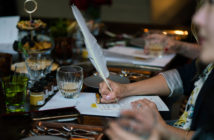What is Yellow Tea? Yellow tea takes its name from its straw colored liquor. The production process is similar to green tea, but with a unique additional step called men huan, or “sealing yellow.”
After very early spring buds or tips are pan-fired, they are wrapped in special cloth, a step that is repeated several times over a period of up to three days, gently oxidizing the leaves before the final slow charcoal drying. This smothering process pulls the aromas back into the buds and creates a more aromatic and mature tea, free of the “grassy” taste and astringency found in many green teas.
Because yellow tea is rare, purchasing in the West should be undertaken with care. Poor quality green tea is sometimes sold as yellow tea in the U.S.; therefore, it is important to purchase yellow tea from a reputable tea vendor that deals directly with the tea farm in China. While Korea produces a “yellow tea,” it is an unrelated tea and does not follow the same process as Chinese yellow tea.
Also known as: Huang Ya; varieties include Jun Shan Yin Zhen (Hunan), Mo Gan Huang Ya (Zhejiang), and Meng Ding Huang Ya (Sichuan).
Origin: The rarest of the six classes of tea, yellow tea is only produced in China, in the high mountains of Hunan, Zhejiang and Sichuan provinces. Jun Shan, rumored to have been the favorite tea of Chairman Mao, is only grown on the mist-covered mountain of Jun Shan Island, a 1 km wide island that produces a mere 500 kilograms of tea per year. Pickers gather only the bud by breaking it from its stem with a twist. It takes 60,000 of these carefully harvested buds to yield just one kilogram of Jun Shan Yin Zhen. Because its production is difficult and time-intensive, yellow tea has primarily been consumed by locals. As the demand for easier-to-make green tea has increased in the West, many have abandoned the production of yellow tea in favor of green, and knowledge of the yellow tea-making process is being lost in China. Today, there are few tea masters alive with the skills required to make yellow tea.
Steeping tips: Steep one tablespoon (1 teaspoon for bud-only Meng Ding) per 6 oz. of water for 1-3 minutes in water well below boiling (170-180 degrees Fahrenheit). Yellow tea holds up well to multiple infusions, although slightly longer steeping times are recommended for subsequent infusions.
Teaware: Any teaware will work, but steeping in glassware highlights the beauty of the yellow tea leaves as they unfurl.
Taste: Considered a mature tea, yellow tea is smooth and aromatic with a sweet, clean, bright, floral taste and a medium body.
Health Benefits: While the health benefits of yellow tea have not been as extensively studied as those of other teas, many believe yellow tea to be richer in antioxidants than green tea, as the buds are picked earlier in the year. Therefore, while yellow tea is believed to have similar benefits to green tea such as preventing cancer and lowering cholesterol, it may be more effective than other teas in preventing liver damage. Yellow tea is popular among those who want the health benefits of green tea but dislike its “grassy” taste.
note that this was originally published in 2013




